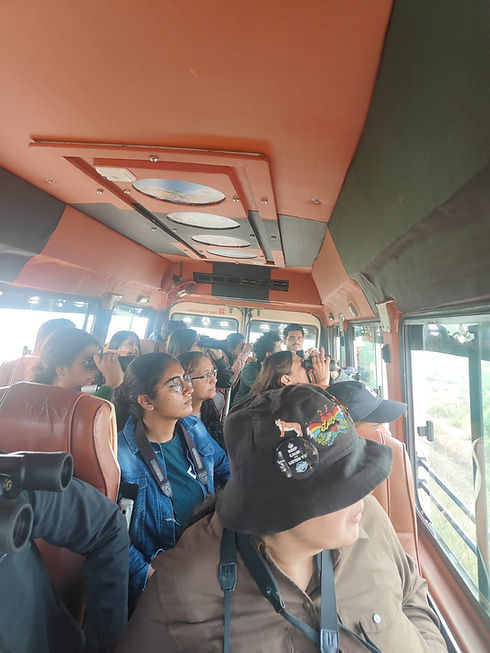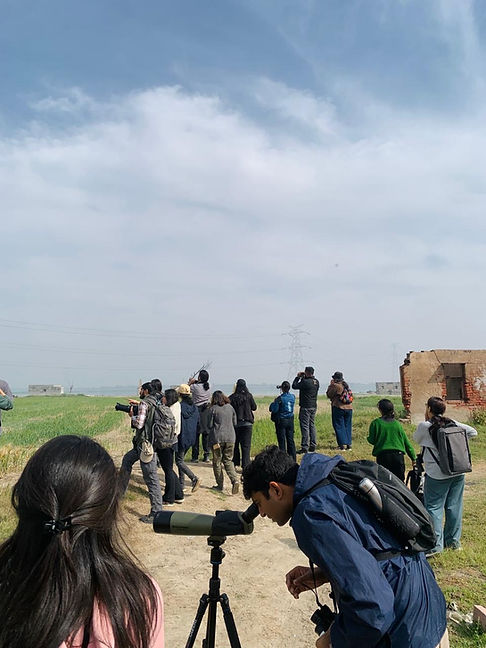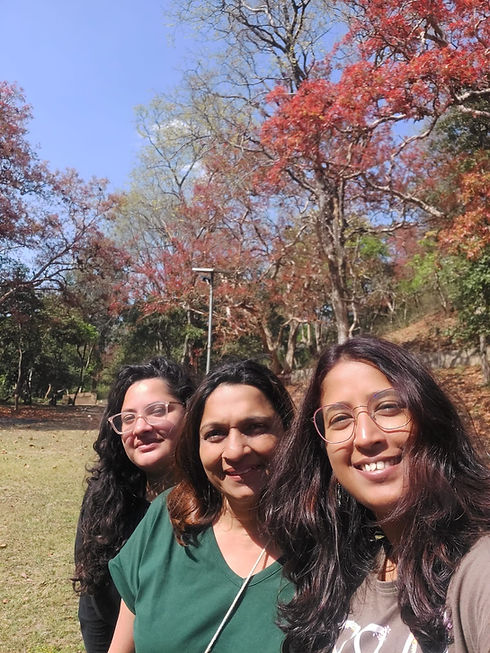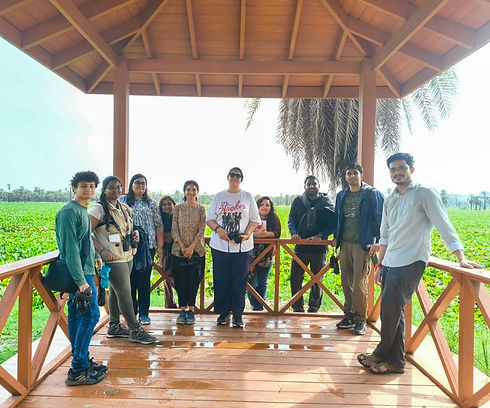Barefoot Birders
A Course in Birdwatching for enthusiasts by WWF-India.
APRIL 2024 - MAY 2024
BAREFOOT BIRDERS 2024 was a course run by WWF-India for adults aimed at educating its participants and helping them become better birders, people from various backgrounds joined, irrespective of their formal education to learn how to identify birds and harness the power of citizen science through e-bird and merlin to record their observations. This course included theory and field sessions, we learned a lot about different birds, bird migration, flyways. There were also notable guest lectures by experts.
This course was led by Nikhil John, a Naturalist from WWF-India's Nature Connect team.
I was fortunate enough to have gotten to be a part of this amazing course, prior to which I only actively recognised Pigeons and Sparrows as birds.


BECOMING A BIRDER: HOW A SINGLE BIRD CHANGED MY LIFE
The hushed hall held a dozen strangers in chairs, all waiting. Then, a calm, assured voice cut through the silence. "I want each of you to think back," he said, "to that exact moment or encounter that stirred something in you—a reason you're here. That unspoken tug that made you want to learn more about birds, to sign up for this course."
It hadn't been dramatic or even entirely deliberate for me. There was no childhood dream or academic pursuit that brought me there. It was a single moment, unannounced and unrehearsed, that had wedged itself firmly in my memory.
A mountain path.
A flash of sapphire.
A sound that didn't belong to any memory I'd ever had.
I'd been wandering alone in the mist-laced woods of Binsar, a phone in hand but my mind elsewhere. Not searching for birds. Not even noticing them, really.
And then—it flew past.
The smallest blue I'd ever seen. Not dull blue, not grayed with shadow, but lit from within like a flicker of sky had detached itself and taken flight between the trees.
It paused only for a second, its call foreign and melodic. I stopped mid-step. I didn't know why, but my heart had lurched, caught by something deeper than recognition. A question had taken root before the bird even vanished: What was that?
That evening, I searched for answers the only way I knew how—my fingers flying across my phone screen. "Tiny blue bird in Uttarakhand mountains." And there it was, a perfect match with a name that seemed like it belonged in a spell book: Verditer Flycatcher.
It should have ended there. But it didn't.
I found myself Googling strange things: Do people watch birds? Is birdwatching a real thing?
And now, here I was—sitting in a circle of strangers, carrying a notebook with nothing written inside. Everything felt alien.
But inside me, something had begun to stretch. I didn't know it yet, but this small act—of listening, of remembering, of daring to be curious—would mark the true beginning of a transformation. One that would change my life. One that would take me into forests I couldn't name yet, to friendships not yet formed, and toward countless birds I didn't yet recognize.
THE QUIETEST VOICE IN THE ROOM
I’d always seen the classroom as my domain. For nearly a decade, I'd stood at the front, marker in hand, shaping young minds, guiding them through language's nuances. But now, for the first time in years, I found myself in a chair at the back of someone else's classroom—and the shift felt exciting.
Hours after our first session, the session’s impressions still clung to me like pollen after a summer walk. Now, at home, I sat by my window. The faint outline of a bird outside caught my attention, but my thoughts were still inside that auditorium. I could still picture the slide deck—those frozen mid-flight bird silhouettes—and hear the steady cadence of our mentor's voice as he explained identification features and bird calls.
"Wing bars."
"A Wagging Tail "
The terms landed like unfamiliar punctuation marks in a language I hadn't yet learned to read. The other participants, some seasoned birdwatchers, spoke with an unsettling ease, though this was completely new for me, it was also captivating. I had never observed nature in the same way before.
I was, by my own estimation, the least experienced person in the room. And that knowledge brought with it a strange sense of freedom—no expectations, no reputation to uphold. Just room. Space to be curious. Space to not know. Space to grow.


MY FIRST: BIRDWATCHING LIFER & FRIEND
The early morning light at Asita Wetland was a quiet warmth, a soft gold brushing against dewdrops and settling gently on my arms as I stood waiting.
I'd arrived early—partly out of eagerness, partly to avoid the awkwardness of walking in late to a group that still felt loosely connected by unfamiliar faces and half-formed names.
I hadn't expected to feel what I did: not nervousness, exactly, but a tremble of wonder at the park itself.
How had I not known this place existed?
I had lived my entire adult life in this city, and yet, tucked beside the very neighbourhoods I frequented for coffee and errands was this quiet, green world by the Yamuna's edge, teeming with life I had never paused to notice.
The disbelief had knotted in my chest when I'd first pulled up the directions. It was a soft punch of realisation.
But instead of spiralling into self-judgment—like I once might have—I simply acknowledged it. I had been disconnected. Of course, I had. And this course, this slow unraveling of old habits and the careful weaving in of new ones, was the first honest step I had taken toward changing that.
I looked down at my shoes—cushioned walking sneakers with soft mesh sides, never meant for wild terrain—and winced slightly as another twig jabbed the sole. I had repurposed what I had: gym clothes, and a bottle of water wedged into a sling bag too small for the field. It wasn't ideal. But it was enough.
And then—the bird.
It appeared suddenly, flitting near a low hedge in a burst of energy. Black and white. Confident. Sharp. Not a myna, but close enough to mistake it for one. I crouched slightly, as if doing so might bring me closer to understanding it. It tilted its head, eyes scanning the ground with precision, then darted forward, plucking a tiny worm from the grass. And just like that, it was gone.
I stood frozen, mouth parted slightly in silent awe.
For the first time, I had seen the food chain not as a diagram in a textbook or a slide in a presentation, but as a living moment. The bird, the insect, the grass, the morning light—all part of something far larger and more intricate than I had ever truly considered.
It stirred something in me. Not just interest. Reverence.
I might've stayed in that stillness longer if not for the growing hum of voices behind me. The rest of the group had arrived. Laughter and greetings echoed.
There was still a softness to my confidence, an uncertainty that I was nursing like a delicate sprout. But I couldn't hold it in either—the desire to name what I'd seen. To place it. To know.
MY FIRST: BIRDWATCHING LIFER & FRIEND
So I approached the nearest person, a woman with a field bag and binoculars already strung across her chest.
"Hey," I said, feigning casual, "I just saw a bird. It was black and white, kind of myna-sized. I don't think it was a myna, though."
The woman blinked and smiled. "Hmm, could be an Indian Pied Starling. Starlings are pretty similar. Did it have a bit of orange near the eye?"
My eyes lit up. "Yes! Yes, I think so!"
Without a word, the woman pulled out her phone, tapped into the Merlin Bird ID app, and turned the screen toward me.
And there it was. The exact bird. Its gaze familiar now. As if it had followed me into the app.
Indian Pied Starling.
My first lifer.
I didn't know the term yet. Didn't know that birders marked such sightings like milestones. But I felt it. Something had shifted. I had crossed an invisible threshold—from not-seeing to seeing. From not-knowing to beginning.
As the group began to walk deeper into the park, I hung back for just a moment. Not because I felt unsure, but because I wanted to carry this moment with me. My first true step.
And ahead—birds, trees, soil, and silence waiting to be filled.
I followed.


FROM BAREFOOT BIRDERS TO...
The journey from being a Barefoot Birder to the next chapter was nothing less than an adventure of a lifetime. Preetika, my friend, quickly became a touchstone for me. Her quiet encouragement and lack of condescension built a friendship over long walks, shared binoculars, and whispered excitement. We made a habit of heading out on our own, exploring city edges, reed-beds, and lakes and wetlands.
It was with her that I journeyed to Sonkhliya, Rajasthan.
The sun-bleached grasslands greeted us with open arms, shimmering in the morning haze. We waited, scanning the earth and sky for a glimpse of the Lesser Florican—India's elusive, acrobatic phantom.
The grasses danced in the wind, concealing and revealing. And then, suddenly, it was there.
A leap. A flick of black and white. Upward, spinning, almost magical.
I watched in stunned silence, eyes wide, breath caught somewhere in my chest. This was my one-hundredth lifer.
Later that evening, alone with my thoughts and a dim screen, I searched article after article. Words like endangered, grassland collapse, habitat loss, and hunting filled the page. Woven into the tragedy was a particular kind of horror: once, this bird's dazzling display had been bait. Hunters had waited for its courtship leap and fired mid-air.
It wasn't just a statistic. It was a haunting.
A quiet despair took hold, knotted with guilt. I thought of all the years I'd lived in the city, oblivious to the beautiful, mesmerizing creatures disappearing under my very nose. I thought of ancestors—mine, ours—who might have cheered while the bird fell. I thought of all the people who would never know the florican even existed.
Image on the left by Preetika.
...THE BEGINNING OF THE NATURE EDITION
And then, another voice, quieter but firmer, rose to meet the despair.
Maybe I wasn't a conservationist in the scientific sense. Maybe I couldn't wield numbers, or data, or government policy. But I had something else. A lifetime of working with words. The ability to communicate. The instinct to explain, to move, to evoke.
Perhaps, I realised, that could be enough.
I remembered all the students I had taught, all the ways I had broken down complex grammar into something digestible, alive.
Could I not do the same with birds? With extinction? With wonder?
If I could write even one story that made someone pause their scroll, look up, and remember the name "Lesser Florican," perhaps that bird would have one more ally.
That night, in the faint glow of my headlamp, I opened my notebook. My hands trembled slightly as I wrote:
"Today, I saw a bird leap into the sky like a secret trying to escape extinction. I saw a story in feathers. I will not let it go untold."
I didn't know yet where this new purpose would lead. But for the first time in years, something inside me felt whole again.
Not because I knew the most. But because I finally knew what I was meant to do.
The night I returned from Sonkhliya, something had shifted. Even with my tired limbs and sun-drenched skin still humming from the heat of the plains, my mind was wide awake, stirred by the rhythmic leap of a bird that few had seen, and fewer still remembered.
The Lesser Florican had stitched itself into my imagination—not just as a bird, but as a living question: What could I do?
And slowly, a single answer began to take shape.
I would write.
Words had always been my companions, my strength. I had used them to teach, to express, to connect.
Now, I would use them to bear witness. To document, to advocate, to care.
That week, I registered a domain name: The Nature Edition.
Image on the right: Barefoot Birders



